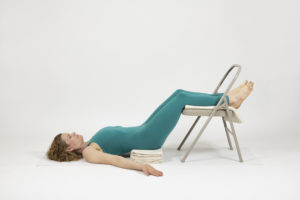
by Leza
It’s a busy time of year, and as much as we need sleep, sometimes our “to do” list keeps our minds active, making restful sleep elusive. I’ve found that practicing a calming breath followed by this sequence before bedtime helps me to fall asleep, stay asleep, and wake up refreshed. (I also take out a notepad and jot down all those things on my “to-do” list, knowing they will still be there in the morning for me to tackle.)
Before practicing, I find it helpful to set an intention, phrasing it in a positive way like an affirmation. Some examples are: “I am at peace,” “I am relaxed,” or “I am grateful.” Take a moment before starting your practice to place your hand on your heart and ask yourself what is needed in this moment. That can be your intention, so that whenever the mind wanders, you can guide it back to the mental focus you gave yourself at the outset.
This sequence is so simple to do and so effective, that even if it does not lead you to deep slumber, it will certainly induce relaxation and calm. And what a gift that is, especially during the busy holiday season! I also find that writing down my to-do list before bedtime takes away the urgency, and I usually end up finding one or two things on it that simply can wait, or don’t need to be done at all. I always feel so much more relaxed and spacious after this sequence, finding it a comforting way to re-set the nervous system and quiet the mind.
By the way, the sequence includes both Legs Up the Wall pose and Instant Maui pose. This is because inverting your legs helps regulate your body’s circadian rhythms, promoting more restful sleep. For that reason, these poses are recommended for insomnia, as well as helping to overcome jet lag. If time is an issue, you can shorten the sequence by doing only one of the inversions—Instant Maui or Legs Up the Wall—rather than both.
1. Calming Breath Practice (Extending the Exhalation), 3-5 minutes.
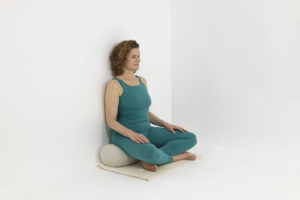
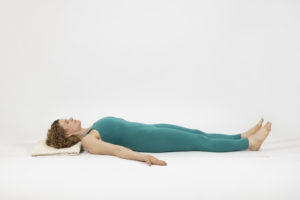
Find a comfortable seated position or lie down. Take a few full breaths, releasing any tension on the exhalations. Then consciously begin to focus on the breath, finding the place it is easiest to access—perhaps your belly or your chest. Don’t try to change anything, just become aware of the natural rhythm. You might notice how the belly and chest rise and expand on the inhalation, and then fall and contract on the exhalation. Notice and observe for a few minutes. As you bring your awareness to the breath, it might naturally begin to slow and deepen. When you’re ready, practice extending the exhalation. You can do this by consciously lengthening the exhalation, making it longer than your inhalation. Practice this for 2-5 minutes, as long as you’re comfortable. You can also practice this breath in the restorative poses that follow, if it feels comfortable to do so. See this excellent article Calming Breath Practice: SOS for Panic Attacks and More by Nina for more detailed instructions on the practice
When you’re done, if you are lying down, bend your knees and come onto your side, resting there for a few minutes. Place your hands on the floor and gently lift yourself up, head last. Come onto your hands and knees on your yoga mat. Prepare the bolsters, blankets, blocks, chair, and any other props you will need for the sequence.
2. Cat-Cow Pose, 6 to 12 rounds.
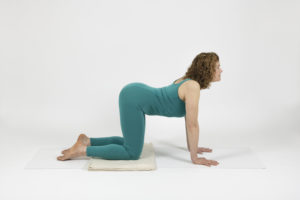
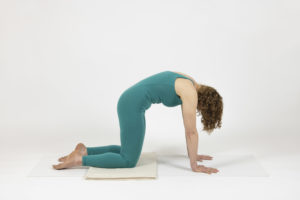
This gentle movement warms up the spine and releases lower back tension. As you inhale and exhale, connect movement with breath, cultivating a non-judgmental, present-moment awareness.
As you inhale, gradually arch your spine into a gentle backbend, the Cow Pose. Moving from your pelvis, lift your tailbone and sitting bones as the pelvis tips forward. Release your belly while keeping your lower back down. Lift your chest and head, keeping the heart lifted and the collarbones spread as you press your hands into the ground. When you’re ready to exhale, move into the Cat pose. Gradually round your spine toward the sky. Move from the pelvis, gently tucking your tailbone and bringing the sitting bones down as the pelvis tips backwards. Gently hollow your belly out towards your spine, releasing your neck and head toward the floor. If comfortable, your gaze can be at the knees. Allow your neck to be relaxed as you continue pressing your hands into the floor.
Enjoy the dance of movement and breath, noticing any sensations that arise. On the inhalation, move back into Cow pose. Alternate between Cat and Cow pose for six to twelve rounds, as long as you’re comfortable. See Featured Pose: Cat-Cow Pose for more information about practicing this dynamic pose.
When you’re done, sit back on your heels in Child’s pose.
3. Supported Child’s Pose, 1.5 to 2. 5 minutes per side.
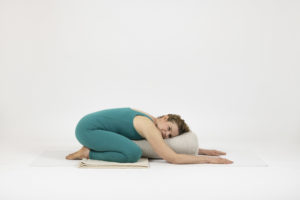
This deeply restful pose calms the nervous system, nurturing both body and spirit. It brings awareness away from the external and into your own inner landscape, where you can send yourself loving thoughts and care.
You’ll need the following: a blanket and a bolster. If you don’t have a bolster, you can stack two folded blankets instead. Place your bolster horizontally in the center of your mat or fold two blankets into rectangles and stack one on top of the other to act as a bolster. If your knees need cushioning, place a folded blanket in front of the bolster or blanket stack.
Kneel at the back of the bolster or blankets so your knees, legs, and feet are on the ground or the cushioning blanket. Point your toes backward (do not tuck them under), with your big toes lightly touching and your knees bolster-width apart. Before bringing your bolster into position, sit down on your heels.
Slide the bolster or blanket stack so that the prop touches your mid-inner thighs. Keeping your hips low, fold your belly and chest over the bolster, turning your head to the side so your cheek can rest on the support. Allow the prop to support the entire front body. If there is a gap between your buttocks and feet, place a blanket under your buttocks.
When you’re comfortably supported, bend your arms at the elbows while keeping your upper arms in line with your shoulders. Rest your forearms on the floor, parallel to your body. See Featured Pose: Supported Child’s Pose for more information on practicing this pose.
4. Legs Up the Wall Pose, 5-15 minutes.
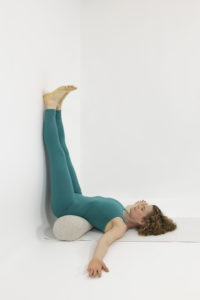
You’ll need the following: a bolster or a stack of blankets and an optional support for your head or neck. Move your mat with the narrow end against a wall. Place a bolster or stack of blankets parallel to and about six inches away from the wall. If your hamstrings are tight, move the bolster or prop further from the wall. If you need support under the knees, place a rolled-up blanket there. If you need support under the neck, place a rolled-up towel or neck pillow near where your head will be when you’re lying down.
To get into the pose, sit on the end of the bolster with your knees bent and feet on the ground. Scoot toward the wall so that the side of your hips is touching it. Place one hand on the ground for stability as you swivel toward the wall and move to the center of the bolster. Extend your legs up the wall, then slowly lower your upper body and head to the mat, stabilizing yourself with your hand. If desired, move the small support under your neck.
Allow your back body to release to the ground. Make sure the back of your pelvis is resting evenly on the center of the bolster. The legs should be straight, with feet either together or hip-distance apart, and the heels against the wall. If the legs are not straight against the wall, try using a rolled up a blanket behind your knees or moving the prop under your hips a bit further from the wall, as stated above. Relax your arms out to the sides.
To come out, slide your feet down the wall and bend your knees toward the chest. Gently roll to one side to come off the bolster. Place your hands on the ground and slowly press yourself up to a seated position, bringing your head up last. See Featured Pose: Legs Up the Wall Pose for more information about how to practice this pose.
5. Instant Maui (Easy Inverted Pose), 5-15 minutes.

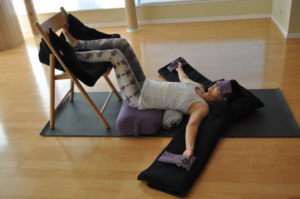
You’ll need the following: a chair with an opening at the back (or a couch, or ottoman), a bolster or blanket stack, and an optional neck pillow or rolled-up towel to place under your neck, if desired.
Place the chair at the foot of the mat or bring the mat up to the edge of a couch or ottoman. Fold a blanket into a square and place it on the seat of the chair (leaving some hanging over the sides/edge to fold over the feet). Taller people may need to add extra blankets on top of the chair so their calves can rest comfortably on the support.
Place a bolster horizontally across the mat, at least several inches away from the legs of the chair or the edge of the couch. The longer your legs are, the further away from the chair legs or edge of the couch the bolster needs to be—taller people may need to have it as a foot or even more away. When you’re in the pose, your thighs should be at a comfortable angle, not straight down from the support.
If you want to provide cushioning for your head, place a blanket or neck support where your head will be.
Keeping your pelvis on the bolster, scoot up close to the chair, so that your knees rest right at the chair edge. Place the back of your calves evenly on the chair or couch. If it’s comfortable, your feet can rest against the back of the chair like the photo on the right but people with longer legs will need to take their feet through the opening at the back of the chair in order to have the backs of their knees at the edge of the seat like the photo on the left. If your chair has no opening, you can turn it sideways.
Lie back onto the props and ground. If you’re using them, make sure your blanket and neck pillow provide ample support under your head and neck (all the way to your shoulders) so that you can drop your chin and look toward your heart. If your legs aren’t relaxing comfortably on the support, try moving the bolster or adding more blankets under your legs.
Allow your chest to be broad and soft. Extend your arms away from the body, palms up. Allow the backs of your hands to rest on the floor, and let your fingers be soft. See Featured Restorative Pose: Instant Maui for more information about how to practice this pose.
6. Supported Savasana, 5-15 minutes.
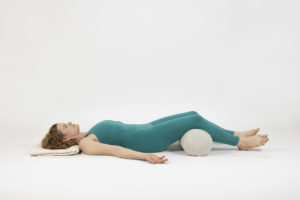
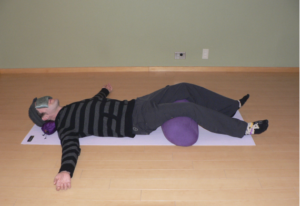
You’ll need the following: yoga mat, 1 bolster for under the knees, 1 neck pillow or rolled towel for under the neck, 1 blanket to cover your body, and an eye pillow, washcloth, or soft scarf. A sandbag is optional. If you don’t have a bolster, you can use pillows or rolled-up blankets. If you don’t have a sandbag, you can use a bag of rice or other grains.
Place your neck pillow or rolled-up towel or blanket at the top of your mat to support your head and neck. Place a bolster or rolled-up blanket at the bottom of the mat for under your knees.
Lie on your back with your knees bent and feet on the floor. Position your head on the neck pillow or head support so that your neck is long and your chin is tucked gently towards the chest.
Lift your feet up and over the bolster, and release your legs onto the bolster, so the backs of your knees rest on the bolster and your heels touch the ground. Let your legs relax and allow the feet to fall out naturally to the sides. This supports the hips to gently roll open.
When you’re settled, place the eye pillow, washcloth, or soft scarf over your eyelids. Before releasing into the pose, you might repeat your intention or affirmation a few times, then release that, too.
See Featured Restorative Pose: Supported Relaxation Pose for more information about practicing this pose.
You can read more about Leza’s writing at www.lezalowitz.com and about her yoga studio and classes at www.sunandmoon.jp.
• Follow Yoga for Healthy Aging on Facebook and follow Nina on Instagram • Order Yoga for Times of Change here and purchase the companion videos here • Order Yoga for Healthy Aging: A Guide to Lifelong Well-Being here.


Leave A Comment